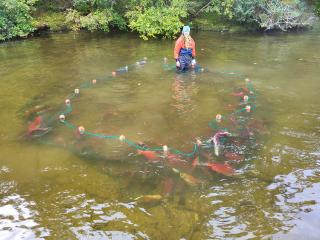Alaska launches online subsistence tool
ALASKA— Southeast Alaska subsistence users have a new tool to help them better allocate valuable time and resources for fishing and hunting. Tongass National Forest’s subsistence dashboard provides all the information harvesters need in a single resource.
Subsistence program manager Robert Cross noted that the tool was created in response to feedback and requests by tribal organizations and subsistence users throughout Southeast Alaska. “We heard how difficult it was to find subsistence data and understand regulatory boundaries, so we got to work on a solution.”
The dashboard consolidates data from hard-to-find locations, transcripts, and technical reports in an accessible, easy-to-use format for the public.
The site includes:
A homepage with information about the Tongass Subsistence Program and Fisheries Resource Monitoring Program, links to reports and the Alaska Federal Subsistence Management Program Facebook site, and subsistence program manager contact information.
A sockeye harvest and escapement page, which shows trends in fish returns and harvest. Elements of the page include:
Current escapement (the number of fish allowed to leave the fishery and spawn) for all sockeye monitoring sites, including real-time escapement for two longstanding projects which serve as pilots for the dashboard—Redoubt Bay and Klag Bay near Sitka.
An interactive map showing currently funded and past fisheries resource monitoring program sites, which provides historical context to escapement reports. This helps harvesters make critical decisions on when to spend fuel and time to harvest and avoid traveling in dangerous waters when salmon numbers are low.
Links to current state and federal regulations, so harvesters are aware of catch limits, seasons and gear allowed for subsistence fishing.
A wildlife special actions page, which outlines federal, in-season closures and their regulatory boundaries. The page also:
Contains special action maps for moose and mountain goat harvests.
Illustrates areas that are open and closed to hunting.
Tallies harvest quota and remaining quota.
Lists all seasonal and current wildlife management action plans.
Relieves the public from searching multiple sites for regulations, helping them avoid unnecessary citations.
Enables harvesters to determine which areas are worth hunting in based off the remaining quota.
A deer harvest page which shows regulatory boundaries and hunting seasons based on land ownership on Prince of Wales Island. The map allows harvesters to zoom in to see boundaries and avoid hunting in closed areas.
Offline maps that can be downloaded and taken into the field by harvesters to easily determine regulatory boundaries while they are hunting, even when offline.
These pages come as a major upgrade to the prior system used for subsistence management. Up until the release of the dashboard, fish trend data was collected and sent from tribal and Forest Service crewmembers to the technical subject matter expert, who would then need to manually enter the data into the system for the public to access. Thanks to the dashboard, those updates are made in real time with no additional manual entry required.
The overall goal of the subsistence dashboard is to provide publicly available data in a single, convenient location online, rather than various reports and papers published by multiple state and federal agencies.
Fish biologist Ashley Bolwerk has managed the Redoubt Lake sockeye monitoring program for two years and says she has often been stopped in the grocery store or received text messages asking for the latest sockeye numbers. With the new dashboard, Bolwerk said, “Tribal partners and the public can access the latest sockeye updates for Redoubt as they come in from the field crew, giving them the same information I have right at their fingertips.”
However, developing this useful tool from the ground up was no small task.
RL Martens, geographic information system specialist for the Tongass National Forest, worked the technical side of the dashboard—building the interactive maps. Incorporating feedback from Sitka Tribe of Alaska, the public and subject matter experts, he created the dashboard to meet the requested needs.
“It was a huge technical effort to build this dashboard, from setting up systems to ensure that the data stays up to date, to creating a design that was easy to navigate,” said Martens. “Knowing that the people we serve wanted better access to subsistence information and creating a product to fill that need made all the effort worth it.”
Sitka Tribe of Alaska’s Kyle Rosendale shared kudos for the work that went into making the dashboard a reality.
“Rob Cross deserves considerable credit for the vision to expand our partner project at Redoubt Bay and Klag Bay to include fishing and hunting throughout the Tongass. We also appreciate Ashley Bolwerk for seeking and incorporating tribal feedback throughout the development of the project. This is the first time we’re bringing something like this to the Tongass and we are excited to play a part in making this new tool available for subsistence harvesters."
More feedback is expected to come as the dashboard becomes more widely used.
The tool is available for use online.
For more information about the subsistence dashboard, please contact the Tongass subsistence program manager Robert Cross at 907-723-8653.





